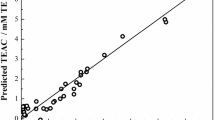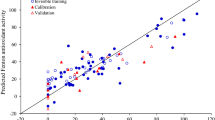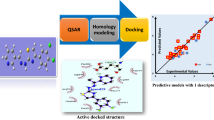Abstract
The antihypertensive activities of a series of pyridazinone derivatives have been modeled using an image-based approach for quantitative structure–activity relationships (MIA–QSAR). First, multivariate image analysis (MIA) descriptors were achieved from bidimensional images. Then, two regression methods were applied to correlate such descriptors with the antihypertensive activities: principal component regression (PCR) and principal component-artificial neural network (PC-ANN) with back-propagation learning algorithm, respectively. Correlation ranking procedure was used to rank the principal components and entered them into the models. The PC-ANN-based model for this series of compounds demonstrated higher predictive ability than the PCR-based model. The results supported that PCR model could predict the antihypertensive activity in pyridazinone derivatives with R 2 ≥ 0.726 for training set and R 2 ≥ 0.622 for validation set, whereas nonlinear method PC-ANN could predict the antihypertensive activity with R 2 ≥ 0.970 for training set and with R 2 ≥ 0.997 and R 2 ≥ 0.982 for validation and test sets, respectively. The obtained results indicated that MIA descriptors may be useful to predict antihypertensive activity of pyridazinone derivatives.


Similar content being viewed by others
References
ACD/ChemSketch (2008) ACD/ChemSketch version 11.02. Advanced Chemistry Development Inc., Toronto
Akahane A, Katayama H, Mitsunaga T (1999) Discovery of 6-oxo-3-(2-phenylpyrazolo[1,5-a]pyridin-3-yl)-1(6H)-pyridazinebutanoic acid (FK 838): a novel non-xanthine adenosine A1 receptor antagonist with potent diuretic activity. J Med Chem 42:779–783
Coelho A, Sotelo E, Ravina E (2003) Pyridazine derivatives. Part 33: Sonogashira approaches in the synthesis of 5-substituted-6-phenyl-3(2H)-pyridazinones. Tetrahedron 59:2477–2484
Demirayak S, Karaburun AC, Beis R (2004) Some pyrrole substituted aryl pyridazinone and phthalazinone derivatives and their antihypertensive activities. Eur J Med Chem 39:1089–1095
Freitas MP (2008) Multivariate image analysis applied to QSAR: evaluation to a series of potential anxiolytic agents. Chemom Intell Lab Syst 91:173–176
Freitas MP, Goodarzi M (2010) MIA–QSAR coupled to principal component analysis-adaptive neuro-fuzzy inference systems (PCA–ANFIS) for the modeling of the anti-HIV reverse transcriptase activities of TIBO derivatives. Eur J Med Chem 45:1352–1358
Garkani-Nejad Z, Ahmadi-Roudi B (2010) Modeling the antileishmanial activity screening of 5-nitro-2-heterocyclic benzylidene hydrazides using different chemometrics methods. Eur J Med Chem 45:719–726
Garkani-Nejad Z, Ahmadvand M (2011) Comparative QSRR modeling of nitrobenzene derivatives based on original molecular descriptors and multivariate image analysis descriptors. Chromatographia 73:733–742
Garkani-Nejad Z, Poshteh-Shirani M (2010) Application of multivariate image analysis in QSPR study of 13C chemical shifts of naphthalene derivatives: a comparative study. Talanta 83:225–232
Gemperline PJ, Long JR, Gregoriou VG (1991) Nonlinear multivariate calibration principal components regression and artificial neural networks. Anal Chem 63:2313
Goodarzi M, Freitas MP (2009) Prediction of electrophoretic enantioseparation of aromatic amino acids/esters through MIA–QSPR. Sep Purif Technol 68:363–366
Hansch C, Leo A (1995) Exploring QSAR: fundamental and application in chemistry and biology. American Chemical Society, Washington DC
Krogsgaard-Larsen P, Liljefors T, Madsen U (2002) Textbook of drug design and discovery. Taylor and Francis, London
Livermone DGH, Bethell RC, Cammack N (1993) Synthesis and anti-HIV-1 activity of a series of imidazo[1,5-b]pyridazines. J Med Chem 36:3784–3794
Longo JG, Verde I, Castro ME (1993) Pyridazine derivatives XIV. Study of the vasorelaxant action of 6-aryl-5-piperidino-3-hydrazinopyridazines in isolated rat thoracic aorta: comparison with hydralazine. J Pharm Sci 82:286–290
Malinka W, Redzicka A, Lozach O (2004) New derivatives of pyrrolo[3,4-d]pyridazinone and their anticancer effects. Il Farmaco 59:457–462
MATLAB (2005) MATLAB version 7.1. Mathworks Inc., Natick. http://www.Mathworks.com
Minitab (2006) Minitab version 15.1.0.0. Minitab Inc., State College. http://www.Minitab.com
Monge A, Parrado P, Font M, Alvarez EF (1987) Selective thromboxane synthetase inhibitors and antihypertensive agents. New derivatives of 4-hydrazino-5H-pyridazino[4,5-b]indole, 4-hydrazinotriazino[4,5-a]indole, and related compounds. J Med Chem 30:1029–1035
Rubat C, Coudert P, Refouvelet B, Tronche P, Bastide P (1990) Anticonvulsant activity of 3-oxo-5-substituted benzylidene-6-methyl-(4H)-2-pyridazinylacetamides and 2-pyridazinylacetyl-hydrazides. Chem Pharm Bull 38:3009–3013
Siddiqui AA, Wani SM (2004) Synthesis and hypotensive activity of some 6-(substituted aryl)-4-methyl-2,3-dihydropyridazin-3-ones. Ind J Chem 43B:1574–1579
Siddiqui AA, Mishra R, Shaharyar M (2010) Synthesis, characterization and antihypertensive activity of pyridazinone derivatives. Eur J Med Chem 45:2283–2290
Sircar I, Weishaar RE, Kobylarz D, Moos WH, Bristol JA (1987) Cardiotonic agents. Inhibition of separated forms of cyclic nucleotide phosphodiesterase from guinea pig cardiac muscle by 4,5-dihydro-6-[4-(1H-imidazol-1-yl)phenyl]-3(2H)-pyridazinones and related compounds. Structure–activity relationships and correlation with in vivo positive inotropic activity. J Med Chem 30:1955–1962
Author information
Authors and Affiliations
Corresponding author
Rights and permissions
About this article
Cite this article
Garkani-Nejad, Z., Poshteh-Shirani, M. Prediction of antihypertensive activity of pyridazinone derivatives through multivariate image analysis applied to QSAR. Med Chem Res 22, 3389–3397 (2013). https://doi.org/10.1007/s00044-012-0356-8
Received:
Accepted:
Published:
Issue Date:
DOI: https://doi.org/10.1007/s00044-012-0356-8




